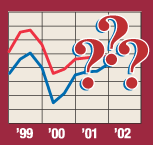World Oil's six editorial advisors comment on the positive turn of events this year with higher oil/gas prices, and even brighter prospects for next year
Dec. 2001 Vol. 222 No. 12 Feature Article WORLD OIL SPECIAL REPORT What’s ahead in 2002 Today’s global economy and upstream market have changed cons
WORLD OIL SPECIAL REPORTWhat’s ahead in 2002Today’s global economy and upstream market have changed considerably from 12 months ago. The question is not whether activity will decline but by how much. Uncertainty fueled by the war on terrorism is the order of the dayEdited by Kurt S. Abraham, Managing/International Editor
The single largest factor behind the deterioration of activity levels and expectations is the steady erosion of oil and gas prices throughout 2001. From a high of roughly $30/bbl in fourth-quarter 2000, average world crude prices have declined to only about $20/bbl in fourth-quarter 2001. Meanwhile, average U.S. natural gas prices at the wellhead have fallen from a high of more than $8/Mcf last January, to only about $3/Mcf at the end of third-quarter 2001. Because such a high proportion of U.S. and Canadian rig activity was tied to drilling for gas, the drop in gas prices has been particularly harmful. In addition, soft crude demand caused by weakening economic performance worldwide (particularly in the U.S.) has dampened investment spending for oil exploration and development. As early as the end of first-quarter 2001, there were strong signals that this year would not be the period of continued economic growth in North America and Western Europe that so many people had hoped for. As the year progressed in the U.S., the question became not when, but how much the rate of growth would decline. Of course, all of these factors were in place before the horrific terrorist attacks of September 11 on New York City and Washington D.C. These incidents only reinforced, sped and deepened the negative economic factors in play. So, what will happen to the E&P industry in the coming year? To a man, all nine of our editorial advisors expect reduced activity levels in the U.S. and Canada. In the U.S., Gulf of Mexico drilling, exclusive of long-term deepwater projects, is forecast to be weaker through much of next year. Onshore rates are also expected to decline up to 15%, if oil prices fall farther. Meanwhile, some estimates place the reduction in Canadian drilling activity at between 15% and 25%. Indeed, this is supported by predictions from the Canadian Association of Oilwell Drilling Contractors and the Petroleum Services Association of Canada. Both groups are predicting that drilling will fall 20% in 2002 – CAODC expects 13,600 wells and PSAC forecasts 14,396 wells, down from between 17,000 and 18,000 wells this year. Outside North America, our advisors still expect good activity levels in West Africa, thanks to the steady string of oil discoveries. Brazil should also remain a strong market for new investment. In the North Sea, the outlook is for a continuation of the moderate recovery that has been underway this year. Our advisor from Norsk Hydro has stated that his company intends to maintain its activities offshore Norway. On the UKCS, development and production work is likely to show some strength, but exploration drilling is not expected to show much growth, if any. Perhaps the biggest wild card in the global E&P market will be Russia, which has demonstrated impressive crude output growth. The country has gained back more than 1 million bopd over the last two years, to go back over 7 million bopd in second-half 2001. While discussing a draft of its forecast due out late last month, IPAA’s Supply & Demand Committee noted that many analysts expect Russia to add another 240,000 to 250,000 bopd in 2002. This unabated growth could become a point of contention with OPEC members, who have become increasingly nervous about the steady slip in oil prices during second-half 2001. Of course, no one can accurately predict what effects the near-term activities of the U.S./UK-led war on terrorism will have on prices and activity levels. Depending on specific incidents, there is room for wild movements in each direction.
|
- Prices and governmental policies combine to stymie Canadian upstream growth (February 2024)
- U.S. producing gas wells increase despite low prices (February 2024)
- U.S. drilling: More of the same expected (February 2024)
- U.S. oil and natural gas production hits record highs (February 2024)
- U.S. upstream muddles along, with an eye toward 2024 (September 2023)
- Canada's upstream soldiers on despite governmental interference (September 2023)
- Applying ultra-deep LWD resistivity technology successfully in a SAGD operation (May 2019)
- Adoption of wireless intelligent completions advances (May 2019)
- Majors double down as takeaway crunch eases (April 2019)
- What’s new in well logging and formation evaluation (April 2019)
- Qualification of a 20,000-psi subsea BOP: A collaborative approach (February 2019)
- ConocoPhillips’ Greg Leveille sees rapid trajectory of technical advancement continuing (February 2019)

 Unbridled enthusiasm has given way to cautious attitudes and some pessimism within the global upstream industry over the course of this year. Compared to the bullish statements and optimistic forecasts made 12 months ago, many industry players and observers are now digging in for an extended period of uncertainty and reduced activity.
Unbridled enthusiasm has given way to cautious attitudes and some pessimism within the global upstream industry over the course of this year. Compared to the bullish statements and optimistic forecasts made 12 months ago, many industry players and observers are now digging in for an extended period of uncertainty and reduced activity.
